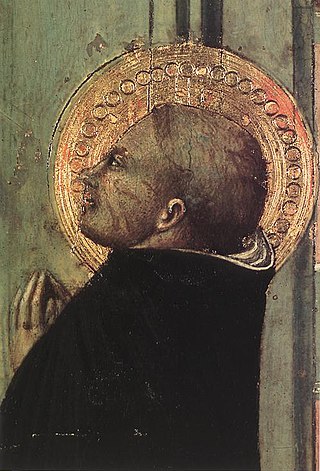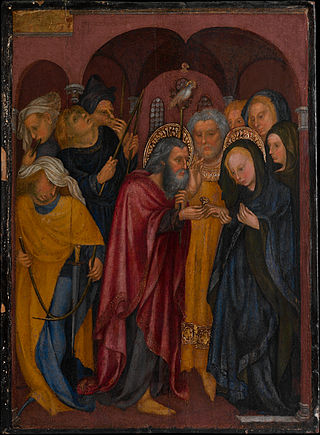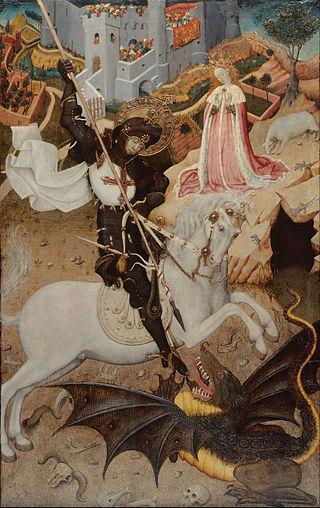
The Metropolitan Museum of Art, colloquially referred to as the Met, is an encyclopedic art museum in New York City. It is the largest art museum in the Americas and the fourth-largest in the world. With 5.36 million visitors in 2023, it is the most-visited museum in the United States and the fourth-most visited art museum in the world.

Hans Memling was a German-Flemish painter who worked in the tradition of Early Netherlandish painting. Born in the Middle Rhine region, he probably spent his childhood in Mainz. During his apprenticeship as a painter he moved to the Netherlands and spent time in the Brussels workshop of Rogier van der Weyden. In 1465 he was made a citizen of Bruges, where he became one of the leading artists and the master of a large workshop. A tax document from 1480 lists him among the wealthiest citizens. Memling's religious works often incorporated donor portraits of the clergymen, aristocrats, and burghers who were his patrons. These portraits built upon the styles which Memling learned in his youth.

The Adoration of the Magi or Adoration of the Kings or Visitation of the Wise Men is the name traditionally given to the subject in the Nativity of Jesus in art in which the three Magi, represented as kings, especially in the West, having found Jesus by following a star, lay before him gifts of gold, frankincense, and myrrh, and worship him. It is related in the Bible by Matthew 2:11: "On entering the house, they saw the child with Mary his mother; and they knelt down and paid him homage. Then, opening their treasure chests, they offered him gifts of gold, frankincense, and myrrh. And having been warned in a dream not to return to Herod, they left for their own country by another path".

Spinello Aretino was an Italian painter from Arezzo, who was active in Tuscany at the end of the 14th and the first decennium of the 15th century. His style influenced the development of late 14th- and early 15th-century painting in Tuscany.

The Temptation of Saint Anthony is an often-repeated subject in the history of art and literature, concerning the supernatural temptation reportedly faced by Saint Anthony the Great during his sojourn in the Egyptian desert. Anthony's temptation is first discussed by Athanasius of Alexandria, Anthony's contemporary, and from then became a popular theme in Western culture.

For the village near Livorno, see Sassetta, Tuscany

Simon Bening was a Flemish miniaturist, generally regarded as the last major artist of the Netherlandish tradition.

Giovanni di Paolo di Grazia was an Italian painter, working primarily in Siena, becoming a prolific painter and illustrator of manuscripts, including Dante's texts. He was one of the most important painters of the 15th century Sienese School. His early works show the influence of earlier Sienese masters, but his later style was more individual, characterized by cold, harsh colours and elongated forms. His style also took on the influence of International Gothic artists such as Gentile da Fabriano. Many of his works have an unusual dreamlike atmosphere, such as the surrealistic Miracle of St. Nicholas of Tolentino painted about 1455 and now housed in the Philadelphia Museum of Art, while his last works, particularly Last Judgment, Heaven, and Hell from about 1465 and Assumption painted in 1475, both at Pinacoteca Nazionale (Siena), are grotesque treatments of their lofty subjects. Giovanni's reputation declined after his death but was revived in the 20th century.
Sano di Pietro or Ansano di Pietro di Mencio (1405–1481) was an Italian painter of the Sienese school of painting. He was active for about half a century during the Quattrocento period, and his contemporaries included Giovanni di Paolo and Sassetta.

Joos van Cleve was a leading painter active in Antwerp from his arrival there around 1511 until his death in 1540 or 1541. Within Dutch and Flemish Renaissance painting, he combines the traditional techniques of Early Netherlandish painting with influences of more contemporary Renaissance painting styles.

The Master of the Osservanza Triptych, also known as the Osservanza Master and as the Master of Osservanza, is the name given to an Italian painter of the Sienese School active about 1430 to 1450.

Saint Luke Drawing the Virgin is a large oil and tempera on oak panel painting, usually dated between 1435 and 1440, attributed to the Early Netherlandish painter Rogier van der Weyden. Housed in the Museum of Fine Arts, Boston, it shows Luke the Evangelist, patron saint of artists, sketching the Virgin Mary as she nurses the Child Jesus. The figures are positioned in a bourgeois interior which leads out towards a courtyard, river, town and landscape. The enclosed garden, illusionistic carvings of Adam and Eve on the arms of Mary's throne, and attributes of St Luke are amongst the painting's many iconographic symbols.

The Marriage of the Virgin is a painting by the Italian late medieval painter Michelino da Besozzo, dating from c. 1435 and housed in the Metropolitan Museum of Art of New York.

The Triptych of Temptation of St. Anthony is an oil painting on wood panels by the Early Netherlandish painter Hieronymus Bosch, dating from around 1501. The work portrays the mental and spiritual torments endured by Saint Anthony the Great, one of the most prominent of the Desert Fathers of Egypt in the late 3rd and early 4th centuries. The Temptation of St. Anthony was a popular subject in Medieval and Renaissance art. In common with many of Bosch's works, the triptych contains much fantastic imagery. The painting hangs in the Museu Nacional de Arte Antiga in Lisbon.

A Goldsmith in His Shop is a 1449 painting by Petrus Christus, a leading painter in Bruges. It is now in the Metropolitan Museum of Art. This is an oil painting on an oak panel that measures 100.1 x 85.8 cm overall and the painted surface is 98 x 85.2 cm. An inscription at the bottom of the painting states "m petr[vs] xpi me· ·fecit·ao 1449· ". In addition, the inscription has an emblem of a clock with a mechanical linkage to a heart, Christus's emblem.

Saint Francis of Assisi Receiving the Stigmata is the name given to two unsigned paintings completed around 1428–1432 that art historians usually attribute to the Flemish artist Jan van Eyck. The panels are nearly identical, apart from a considerable difference in size. Both are small paintings: the larger measures 29.3 cm x 33.4 cm and is in the Sabauda Gallery in Turin, Italy; the smaller panel is 12.7 cm x 14.6 cm and in the Philadelphia Museum of Art. The earliest documentary evidence is in the 1470 inventory of Anselm Adornes of Bruges's will; he may have owned both panels.

The Annunciation is an oil painting by the Early Netherlandish painter Hans Memling. It depicts the Annunciation, the archangel Gabriel's announcement to the Virgin Mary that she would conceive and become the mother of Jesus, described in the Gospel of Luke. The painting was executed in the 1480s and was transferred to canvas from its original oak panel sometime after 1928; it is today held in the Robert Lehman collection of the Metropolitan Museum of Art in New York.

Saints Roch, Anthony Abbot and Lucy or Three Saints is a 1513 oil on canvas painting by Cima da Conegliano, which is now in the collection of the Metropolitan Museum of Art in New York.

Two small paintings in London and New York are believed to come from the same predella, and are attributed to Zanobi Strozzi, a Florentine painter who was probably a pupil of Fra Angelico. They are an Adoration of the Magi in the National Gallery in London, and a Nativity in the Metropolitan Museum of Art in New York. They date to about 1433–34 and are in tempera and gold on panel.

Saint George Killing the Dragon, also known as Saint George and the Dragon is a tempera painting by the Catalan artist Bernat Martorell, painted c. 1434 – c. 1435. It depicts the famous legend of St. George and the Dragon in which the Christian knight, St. George, rescues a princess from a dragon.



















